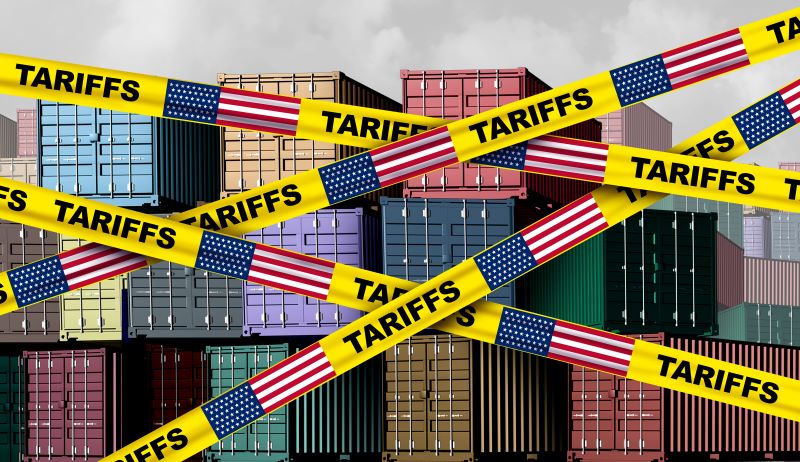Editor’s Note: This op-ed about tariffs from “AV Brains & Brawn” columnist Alan C. Brawn reflects the views of the author. The views expressed herein may not reflect those of Commercial Integrator or its corporate parent. This was originally published on March 17. It has since been updated as of March 20, 2025.
In the AV world, the term most often discussed today (aside from artificial intelligence and “experience”) is tariffs. The reason is that so much of what we buy, and sell is imported, and this can and will impact each of us directly or indirectly. Putting opinions and politics aside it is imperative to deal with what Sgt. Joe Friday of “Dragnet” fame would say, “Just the facts, ma’am.” This article reflects my summation of comments from economists and academics as regards the basic definition of tariffs, how they really work and their impact.
A tariff is a fee (aka levy, duty, or tax) that a government imposes on imported goods. The “trigger” or imposition is when a product crosses a country’s border, the government charges this fee before the product can enter the domestic economy. In the U.S., tariffs are collected by Customs and Border Protection agents at 328 ports of entry across the country. A tariff is different from other taxes in that they directly affect the price of imported goods.
Who Pays Tariffs?
It is imperative to understand who pays tariffs. Countries impose tariffs but, in fact, it is importers (in our example, American companies) that pay tariffs, and the money goes to the U.S. Treasury. Those companies typically pass their higher costs on to their customers in the form of higher prices.
Economists have found that in the past foreign firms absorbed some of the burden of tariffs by lowering their prices, resulting in a combination of foreign businesses and domestic firms and consumers sharing the burden of tariffs. In contrast to past studies, however, recent studies have found that today’s tariffs were passed almost entirely through to U.S. firms or final consumers.
Tariffs have historically been a source of federal revenue but the reliance on them as a prime source has been eclipsed over time with revenue like the federal income tax. Tariffs have become more of a tool to influence economic policy. Residing in a global economy the U.S. tariff policy has shifted to a tool for trade policy and negotiations. Both positive and negative impacts must be considered. This is not a black and white issue so keep that in mind.
Potential Positive Impacts
Potential positive impacts of tariffs:
- Increased revenue
- An instrument in trade negotiations
- Addressing perceived unfair trade practices and imbalance
- Protecting domestic industries by making foreign products less competitive
- Prevent dumping products at unfairly low price
- Promote “made in the U.S.” and protect the supply chain
- Protect intellectual property
- Increase domestic jobs
- Safeguarding national interests.
Potential Negative Impacts
Potential negative impacts of tariffs:
- Alter and negatively affect international relations.
- Lead to retaliatory tariffs or other measures
- Raising the possibility of a trade war
- Destabilizing markets and harming global economic growth
- Impact on supply chain
- Increased prices
- Job loss
- Isolation
The United States has gradually retreated from promoting global free trade and lower tariffs. The U.S. currently has 20 countries with free trade agreements. These include Canada, Mexico, Australia, Korea, Israel, Japan (limited), etc. We began to see a major shift in trade policies in the president’s first administration. And, with the second term, the trade and tariff situation has become a moving target.
On and Off
Many economic analysts view the on/off imposition of tariffs, even on our closest allies with concern, worrying that policymakers aren’t fully examining the cause and effect at play. One example would be the imposition of a 25% tariff on automobiles coming out of Canada and Mexico — a policy that was then “paused” for 30 days. According to Rodney Sullivan, executive director of the Mayo Center of Asset Management at the University of Virginia’s Darden School of Business, “Should the tariffs not be reversed in short order, the likely impact will be weakened economic growth for the U.S. and its trade partners, eliminated jobs and increased consumer costs. The largest potential impacts will be in the agriculture, automotive, consumer electronics and energy sectors.”
One of the overriding benefits touted as a rationale in much higher tariffs was the restoration of manufacturing and protection of manufacturing jobs in the American heartland. Keep in mind that in the U.S. in all sectors combined we are migrating from a manufacturing economy to a service economy. A study by economists at the Massachusetts Institute of Technology, the University of Zurich, Harvard and the World Bank concluded that the president’s original tariffs failed to restore jobs to the American heartland. The study found that tariffs “neither raised nor lowered U.S. employment.”
A cursory fact-check shows that American manufacturing hit an all-time annual high of $2.5 trillion in 2021 and may exceed that in 2025. The other side of the coin is that manufacturing jobs have declined since 1979, when manufacturing employment reached an all-time peak of 19.6 million. In 2024, the US manufacturing sector employed nearly 13 million workers and contributed $2.93 trillion to the economy at an annual rate. The point is that we are manufacturing more in terms of dollars than at any time in our history but with fewer employees. The root cause is that technology is displacing employees in some industries, but overall, this can be misleading. In late 2024 there were 428,000 manufacturing job openings in the U.S. and employers find that some are difficult to fill for a variety of reasons. The good news for us in AV is that technology manufacturing and employment overall in this sector is on the rise.
Related: AVIXA’s Peter Hansen on How Tariffs Will Shape the Pro AV Industry
Let’s bring all this close to home in AV, digital signage and security. Put your thinking caps on for a minute. What do we sell that we actually manufacture in the U.S.? Displays are manufactured in China, Japan, and Korea, to name a few. I did not mention Mexico because that country acts (for the most part) as a parts assembler to help support the supply chain and yes, avoid tariffs. Previously, the “work around” on tariffs has been to assemble and ship from a country like Mexico with a free trade agreement with the U.S.. As we know, that is now subject to change as we speak.
Tariffs Will Mean Higher Prices
Higher tariffs mean that companies importing AV products into the U.S. will have to raise prices. Remember they are the ones to pay the tariffs at the port of entry. An importer can try to work with the foreign manufacturer who might be able to adjust their export prices to counter part of this fee but only a small part and this will vary with the manufacturers. At this point the importers might be able to absorb 5% or even a 10% increase but above that the cost will (by economic necessity) need to be passed on. This initiates a ripple effect where AV integrators will need to increase their prices to their clients, and this ultimately ends up with an increase of prices to the end users. A small price increase will not have a major impact. But when increases reach a threshold of pain, price-wise, then projects will be postponed or even cancelled. Sounds serious, and it is.
The theory is that by imposing high tariffs this will encourage and promote manufacturing in the U.S.. It is much more complicated than that. Let’s look deeper at the top 10 manufacturing countries in the world.
Top Manufacturing Countries (Safeguard Global)
- China – 31.6% Global Manufacturing Output
- United States – 15.9% Global Manufacturing Output
- Japan – 6.5% Global Manufacturing Output
- Germany – 4.8% Global Manufacturing Output
- India – 2.9% Global Manufacturing Output
- South Korea – 2.7% Global Manufacturing Output
- Russia – 1.8% Global Manufacturing Output
- Italy – 1.8% Global Manufacturing Output
- Mexico – 1.7% Global Manufacturing Output
- France – 1.6% Global Manufacturing Output
Rather that bore you with all the details, the Cliff’s Notes version of key strengths in the U.S. and China
U.S. Manufacturing
The United States has carved out a niche for itself in advanced manufacturing, relying on cutting-edge technology, robotics, and skilled labor.
Key strengths include:
- High-Tech Production: Specializing in aerospace, medical devices, defense, and automotive electronics.
- Quality Standards: Strict regulatory compliance ensures superior product quality.
- Innovation: The U.S. invests heavily in R&D, resulting in a high rate of technological advancement.
- Customization: Flexibility in meeting specialized, smaller-scale production requirements.
China Manufacturing
China’s manufacturing landscape is defined by its ability to produce large volumes efficiently.
Key strengths include:
- Large skilled workforce
- Mass Production: Dominance in consumer electronics, textiles, and general-purpose machinery.
- Robust supplier networks within close proximity, reducing lead times.
- Rapid Scalability: Capacity to scale operations quickly to meet global demand.
- Cost Efficiency: Competitive labor costs and government incentives drive affordability.
We can try to “become” like China, and they can try to “become” like us, but in most cases it is not economically feasible and with properly imposed global trade policies (read this win/win) it is not necessary. I want to use the manufacturing of displays as one apparent example of infeasibility. Overseas manufacturing of displays is mature, and the investments have been made. For example, for us to manufacture a large LCD flat panel display in the U.S. there would be the cost of land, building factories, manufacturing all the component parts, investing in and training human resources (labor and management) and a myriad of other things to make it all work. If you add up all the costs to do that plus the time to market factors, the price of manufacturing a typical LCD flat panel in the U.S. would make the price multiple times what the market will bear. The same is true in areas like textiles and high-volume consumer products.
The story does not end with the impracticality of things like manufacturing textiles or high-volume consumer products or, in our case, LCD flatpanels. There are areas where we already excel as noted above. One example is the development and manufacturing semiconductors (aka chips) that go into our AV products. The top five countries providing semiconductors are Taiwan, South Korea, Japan, the U.S. and China in that order. In 2024, some of the top chip companies with significant manufacturing presence in the U.S. include Intel, Nvidia, AMD, Broadcom, Qualcomm, Texas Instruments and Micron Technology.
In a global economy we need to work with allies to maximize what we both have and what we can do together. Think of playing to each participant’s strengths. The best example of U.S. and foreign cooperation is between the U.S. and Samsung. They are building a massive semiconductor chip plant in Taylor, Texas, as part of a broader U.S. effort to revitalize domestic chip manufacturing, with the US government providing $6.4 billion in funding and a total investment of $40 billion. The AV industry will benefit from aggressive chip development and manufacturing in the U.S. and these components will become part of a bigger AV picture (pun intended) .
In conclusion, tariffs can be used as a tool to effectively establish a balance of trade and protect national interests. However, when they’re done in a vacuum, they can be dangerous. Economists warn that isolationism is not the answer. It is a global economy, and we can’t put that genie back in the bottle. Countries will respond to what they see as attacks on them. Isaac Newton’s Third Law of Motion states that for every action (force), there is an equal and opposite reaction. That means that, when one object exerts a force on another, the second object exerts a force back on the first that is equal in strength but in the opposite direction.
The implications of tariffs on all parties in the AV industry — and society broadly — needs to be carefully considered. After all, we’ll all have to live with the outcome.
By Alan C. Brawn CTS, DSCE, DSDE, DSNE, DCME, DSSP, ISF-C











